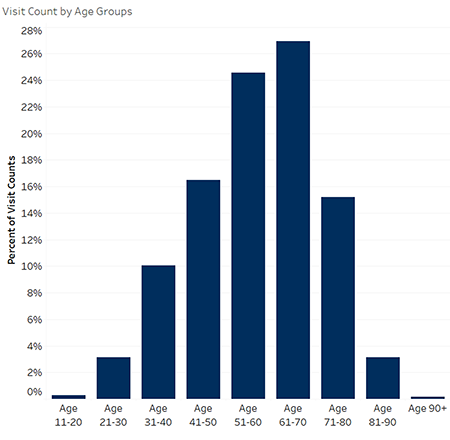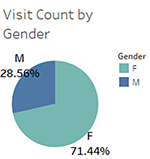
Since 2003, March has been known as Multiple Sclerosis Awareness Month to draw attention to this disease of the central nervous system. This year, March 10-16 is Multiple Sclerosis Awareness Week. As of 2019, almost one million people in the United States are living with MS. According to the National Institutes of Health, multiple sclerosis is “an unpredictable disease of the central nervous system disrupting communication between the brain and other parts of the body.” They also state that many believe MS is an autoimmune disease—meaning that the body launches a defense attack against its own cells. 1 in 5 patients are misdiagnosed due to MS symptoms being nonspecific, and do not appear the same in every person.

The WHA Information Center analyzed claims for multiple sclerosis from January 2019 to September 2023. The age group with the highest visit count is age 61-70 years old, followed closely by ages 51-60. The average age of an MS-related visit is 58 years old. The graph highlights the number of visits rather than diagnosis age. When looking at gender, women account for almost 70% percent of all multiple sclerosis visits to a hospital. That is on track with the national trend where women are three times as likely to be affected by MS than men. The ZIP code with the highest number of visits for multiple sclerosis is in Milwaukee County. The next highest ZIP code is found in Manitowoc County.

The National Institutes of Health records that most people’s first symptoms of MS appear between the ages of 20 and 40. There are many initial symptoms of multiple sclerosis including prickling, or “pins and needles,” double or blurred vision, color distortion for red/green shades, or blindness in one eye. Other symptoms include difficulty with balance and coordination, speech impediments, tremors, muscle weakness in extremities, and in some cases partial or complete paralysis. There is currently no cure, but certain medications may help slow and control symptoms.
Risk factors researchers have found that may possibly cause MS:
- After being exposed to a certain type of slow-acting virus such as measles, herpes or Epstein-Barr, some researchers theorize that MS can develop in genetically susceptible people.
- Some researchers looked at connections between nutrition and MS. There are ideas surrounding a diet rich in saturated fat intake, as well as deficiencies in fish oil and vitamin D, that may increase one’s risk of MS.
- A theory that those living closer to the equator are exposed to more sunlight and therefore are less likely to experience a vitamin D deficiency—supporting the theory that low vitamin D levels increase risk of developing MS.